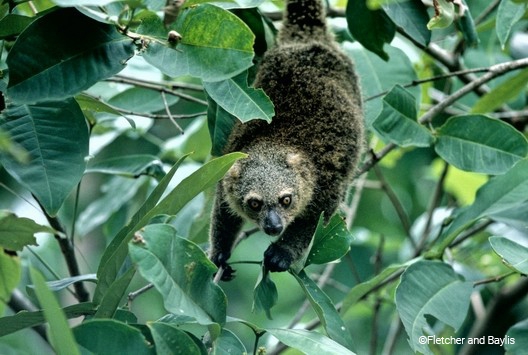| Citation |
|
Description |
Geographic Range [top]
Range Description: This species is endemic to Indonesia, where it has been reported from Sangihe (the largest island in the Sangihe Island group) and Salibabu (within the Talaud Islands). However, although a bear cuscus has been seen and photographed on Sangihe, no specimen from here is known to exist. It has been assumed that this bear cuscus is Ailurops melanotis, but this requires confirmation as the Sangihe Island group is separate from the Talaud Islands and lies closer to Sulawesi, where the more widespread A. ursinus exists.
Countries occurrence:
Native:
Indonesia
Additional data:
? Continuing decline in extent of occurrence (EOO): Yes
? Number of Locations: 1
Range Map: Click here to open the map viewer and explore range.
Population [top]
Population: This species is rare. In the late 1990s survey work on Sangihe and Salibabu Islands failed to locate the species (Riley 2002). This survey work was intense on Sangihe (120 days), but brief on Salibabu (Riley 2002). A captive individual was found on Sangihe and there was local knowledge of the species on both islands (Riley 2002).
Current Population Trend: Decreasing
Additional data:
? Continuing decline of mature individuals: Yes
? Population severely fragmented: No
Habitat and Ecology [top]
Habitat and Ecology: It is though to be restricted to primary forest and gardens next to the Sahendaruman caldera on Sangihe, but on Salibabu it is reported also from degraded forest and adjacent gardens (Riley 2002).
Systems: Terrestrial
Continuing decline in area, extent and/or quality of habitat: Yes
Use and Trade [top]
Use and Trade: This species is heavily hunted. Increased community awareness and enforcement are seen as essential to the conservation of this species, which will require a reduction in hunting pressure and habitat protection (Riley 2002).
Threats [top]
Major Threat(s): This species is heavily hunted (Riley 2002). Its populations are now small and fragmented within its small range (Riley 2002). Although it has been reported from secondary forest and gardens, these individuals are probably dependent on nearby primary forest, which continues to be reduced and degraded by logging, expanding agriculture, and human settlement.
Conservation Actions [top]
Conservation Actions: Riley (2002) states that the key site for the conservation of this species is the Sahendaruman forest block on Sangihe. This forest is 4,268 ha in size, and represents the only remaining sizeable area of primary forest left in the two islands. It was designated as Protection Forest Hutan Lindung (Riley 2002), but it is not strictly protected and is subject to a number of threats (Riley and Wardill 2001). The species is protected under Indonesian law, but there is little enforcement. Increased community awareness and enforcement are seen as essential to the conservation of this species, which will require a reduction in hunting pressure and habitat protection (Riley 2002). Further taxonomic research should be conducted to confirm the identity of the bear cuscus on Sangihe, and field surveys are needed to confirm its continued existence on Salibabu.
Citation: Flannery, T. & Helgen, K. 2016. Ailurops melanotis. The IUCN Red List of Threatened Species 2016: e.T136218A21949526. http://dx.doi.org/10.2305/IUCN.UK.2016-2.RLTS.T136218A21949526.en. Downloaded on 09 October 2018.
Disclaimer: To make use of this information, please check the .
Feedback: If you see any errors or have any questions or suggestions on what is shown on this page, please provide us with feedback so that we can correct or extend the information provided
|

